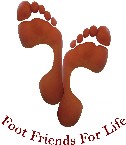Morton's neuroma
CONDITIONS > Pain
Morton’s neuroma
If you’ve ever felt what you might call a ‘pinched nerve’ between your toes, that’s a neuroma.
Known by its correct name of Morton’s neuroma, after a British physician who named the condition after himself when he discovered it over a century ago, Morton’s neuroma is also sometimes referred to as a benign tumour, as the tissue around the affected nerve becomes thick and forms into a mass.
Symptoms of neuroma include pain or tingling, usually between the third and fourth toes, that gets worse over time and leads to severe pain and cramping in the ball of the foot or at the base of the toes. Wearing tight shoes may make the pain worse as the nerve becomes more compressed and pain may also increase when walking due to extra pressure on the nerve. The exact cause of neuroma is unknown, but women have a higher risk of neuroma than men, presumably through increased use of footwear such as tight or high-heeled shoes that have been shown to irritate the nerve.
Neuroma can be treated at home, with some simple measures to relieve pain and pressure on the nerve:
Massage
Massaging the affected area can relieve pain and soothe the nerve.
Apply ice
Icing the area will numb it from pain and will also help to reduce any swelling that may be present between the toes.
Change your shoes
Swap tight or high-heeled shoes for shoes with a wide toe box and a thick, shock absorbent sole to reduce shock and pressure on painful areas.
If pain persists, see your podiatrist. Therapies are available to treat neuroma, with the first course of action being to check for other foot problems that may be adding pressure to the nerve. These problems include conditions such as flat foot or high arches, as well as common foot deformities such as bunions and hammertoes. Getting these conditions treated can alleviate pressure on the nerve, and may be as simple as wearing a custom orthotic device to correct your gait. If neuroma is still causing pain and these measures have been fully explored, your podiatrist may recommend a steroid or anaesthetic injection to relieve pain, or surgery to remove the thickened tissue around the nerve.
What To Consider If You Think You Have A Neuroma
Restrictive footwear
Tight shoes will place pressure on an area that is already under stress due to less space between the toes where neuroma occurs. Switch to wearing shoes with a wide toe box, allowing space for your toes to wriggle and easing the pressure on the affected nerve.
High heels
There’s a reason why women are more likely to suffer from Morton’s neuroma than men; high-heeled shoes will force the weight of your feet downwards, causing the bones of your toes to squish together and push against the nerve. Try switching to a lower heel until the pain subsides.
Shock absorbency
Ensure sport or walking shoes have adequate shock absorbency through thick, supportive soles to reduce pressure on the nerve.
Sport
If you are suffering from neuroma, activities that involve a lot of running can make your symptoms worse. Taking a break from activities that place pressure on the affected nerve will decrease pain. Low impact sports can be taken up to fill the gap, such as swimming or pilates, so you don’t have to miss out while your foot is recovering.
See a specialist
If neuroma keeps coming back, see your podiatrist for treatment. Other foot conditions may be impacting on your neuroma, for example, if you suffer from flat feet, high arches, bunions or hammertoes, extra pressure is being placed on the nerves between your toes. Treatment of those conditions can go a long way to treating the neuroma, and may be as simple as wearing a prescription orthotic device in your shoes.
